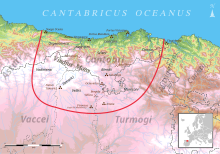
The Bituriges Cubi were a Gallic tribe dwelling in a territory corresponding to the later province of Berry, which is named after them, during the Iron Age and the Roman period. They had a homonym tribe, the Bituriges Vivisci, in the Bordelais region, which could indicate a common origin, although there is no direct evidence of this.
Ambicatus or Ambigatus is a legendary Gallic king of the Bituriges, said to have lived ca. 600 BC. According to a legend recounted by Livy, he sent his sister's sons Bellovesus and Segovesus in search of new lands to settle because of overpopulation in their homeland. Segovesus headed towards the Hercynian Forest, while Bellovesus is said to have led the Gallic invasion of the Po Valley during the legendary reign of the fifth king of Rome, Tarquinius Priscus, where he allegedly conquered the Etruscans and founded the city of Mediolanum (Milan).

The Cantabri or Ancient Cantabrians, were a pre-Roman people and large tribal federation that lived in the northern coastal region of ancient Iberia in the second half of the first millennium BC. These peoples and their territories were incorporated into the Roman Province of Hispania Tarraconensis in 19 BC, following the Cantabrian Wars.

The Aulerci Cenomani were a Gallic tribe dwelling in the modern Sarthe department during the Iron Age and the Roman period. The Cenomani were the most powerful of the Aulerci tribes.

The Varduli were a pre-Roman tribe settled in the north of the Iberian Peninsula, in what today is the western region of the Basque Country.

The Autrigones were a pre-Roman tribe that settled in the north of the Iberian Peninsula, in what today is the western Basque Country and northern Burgos and the East of Cantabria, Spain. Their territory limited with the Cantabri territory at west, the Caristii at east, the Berones at the southeast and the Turmodigi at the south. It is discussed whether the Autrigones were Celts, theory supported by the existence of toponyms of Celtic origin, such as Uxama Barca and other with -briga endings and that eventually underwent a Basquisation along with other neighboring tribes such as the Caristii and Varduli.

The Petrocorii were a Gallic tribe dwelling in the present-day Périgord region, between the Dordogne and Vézère rivers, during the Iron Age and the Roman period.

The Cavarī or Cavarēs were a Gallic tribe dwelling in the western part of modern Vaucluse, around the present-day cities of Avignon, Orange and Cavaillon, during the Roman period. They were at the head of a confederation of tribes that included the Tricastini, Segovellauni and Memini, and whose territory stretched further north along the Rhône Valley up to the Isère river.

The Rauraci or Raurici were a small Gallic tribe dwelling in the Upper Rhine region, around the present-day city of Basel, during the Iron Age and the Roman period.
Bellovesus is a legendary Gallic chief of the Bituriges, said to have lived ca. 600 BC. According to a legend recounted by Livy, the king Ambigatus sent his sister's sons Bellovesus and Segovesus in search of new lands to settle because of overpopulation in their homeland. While Segovesus headed towards the Hercynian Forest, Bellovesus is said to have led the Gallic invasion of the Po Valley during the legendary reign of the fifth king of Rome, Tarquinius Priscus, where he allegedly conquered the Etruscans and founded the city of Mediolanum (Milan).

The Santoni or Santones were a Gallic tribe dwelling in the later region of Saintonge during the Iron Age and the Roman period.

The Aulerci were a group of Gallic peoples dwelling in the modern region of Normandy, between the Loire (Liger) and the Seine (Sequana) rivers, during the Iron Age and the Roman period. They were divided into the Cenomani, the most powerful of them, the Eburovices, the Diablintes, and the Brannovices. The relationship that linked them together remains uncertain. According to historian Venceslas Kruta, they could have been pagi that got separated from a larger ethnic group of the pre-Roman period.
The Brannovīcēs or Aulerci Brannovīcēs were a Gallic tribe dwelling in the modern Yonne department or the Saône valley during the Iron Age and the Roman period. They were part of the Aulerci.

The Eburovīcēs or Aulercī Eburovīcēs were a Gallic tribe dwelling in the modern Eure department during the Iron Age and the Roman period. They were part of the Aulerci.

The Diablintes or Aulerci Diablites were a Gallic tribe dwelling in the north of the modern Mayenne department during the Iron Age and the Roman period. They were part of the Aulerci.
The Nantuates or Nantuatae were a Gallic tribe dwelling around present-day Massongex, in the modern Canton of Valais (Switzerland) and adjacent areas of France, during the Iron Age and the Roman period.

The Bituriges Vivisci were a Gallic tribe dwelling near modern-day Bordeaux during the Roman period. They had a homonym tribe, the Bituriges Cubi in the Berry region, which could indicate a common origin, although there is no direct of evidence of this.

The Turmodigi were a pre-Roman ancient people, later mixed with the Celts people of northern Spain who occupied the area within the Arlanzón and Arlanza river valleys in the 2nd Iron Age.

The Ruteni were a Gallic tribe dwelling in the southern part of the Massif Central, around present-day Rodez, during the Iron Age and the Roman period.

The Nitiobroges were a Gallic tribe dwelling on the middle Garonne river, around their chief town Aginnon, during Iron Age and the Roman period.












